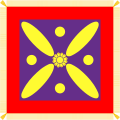King of Kings of Iranians and non-Iranians
| "King of Kings of Iranians and non-Iranians" of the Sasanian Empire | |
|---|---|
| Šāhān šāh ī Ērān ud Anērān (Middle Persian) | |
|
Imperial
|
|

|
|
| Details | |
| First monarch | Ardashir I (224–242) |
| Last monarch | Yazdegerd III (632–651) |
| Residence |
|
The Shahanshahs of the Sasanian Empire (Middle Persian: Šāhān šāh ī Ērān ud Anērān, "King of Kings of Iranians and non-Iranians") ruled over a vast territory. At its height, the empire spanned from Turkey and Rhodes in the west to Pakistan in the east, and also included territory in contemporary Caucasus, Yemen, UAE, Oman, Egypt, Israel, Lebanon, Syria, Jordan and Central Asia.
The Sasanian Empire was recognized as one of the main powers in the world alongside its neighboring arch rival, the Roman-Byzantine Empire, for a period of more than 400 years. The Sasanian dynasty began with Ardashir I in 224, who was a Persian from Estakhr, and was descended from the Achaemenid Kings, and ended with Yazdegerd III in 651. The downfall of the Sasanian Empire proved of great significance and effects to Zoroastrianism, the state religion of the Sasanian Empire. The previous Zoroastrian shahanshahs were replaced with Muslim Caliphs who forced the Zoroastrians and their faith to endure harsh conditions, including the destruction of fire temples throughout the previous Sasanian Empire and marginalization of the faith.
Ardashir I (r. 224–242), the founder of the Sassanian Empire, introduced the title "Shahanshah of the Iranians" (Middle Persian: šāhān šāh ī ērān; Parthian: šāhān šāh ī aryān). Ardashir's immediate successor, Shapur I (r. 240/42–270/72) chooses the titles in a precise manner in the inscription at Ka'ba-ye Zartosht. In that Shapur names four of his Sasanian predecessors with different titles and in "an ascending order of importance" by giving the title (Xwaday) "the lord" to Sasan, "the king" to Papag, "King of Kings of Iranians" to Ardashir, and "king of kings of Iranians and non-Iranians" (Middle Persian: MLKAn MLKA 'yr'n W 'nyr'n šāhān šāh ī ērān ud anērān;; Ancient Greek: βασιλεύς βασιλέων Αριανών basileús basiléōn Arianṓn) to himself. The title "King of Kings of Iranians and non-Iranians" has also seen on a single silver coin of Shapur I, which indicates that the title was introduced after his victory over Romans and incorporation of non-Iranian lands into the Sassanian realms. The title was later used in coins of all later Sassanian kings.
...
Wikipedia
